|
EVOLUTION OF COURT HOUSE SQUARE
These Sanborn maps show
that by 1895, front and rear wood frame porches were
added, and a band stand at the corner of Franklin &
Madison Streets. From 1899 to 1903 the band stand
was moved to the Florida Ave. side--the rear of the
courthouse. In photographs an annex appears behind
the courthouse along Fla. Ave. in 1913.

The 1915 map shows the large brick
addition consisted of offices on the first floor and a
large courtroom on the 2nd floor. The band stand
was relocated to where it was in 1899, but it was
probably not the original one. By 1931,
the courthouse annex was extended on the north end, all
the way to Madison St. Photos show it was extended
by 1926. By this time the Tampa Terrace hotel had
been built on the east side of Fla. Ave. so this was the
view they had from the front terraces and balconies.
The image below is the highest
quality photo of the pre-1900 photos of the courthouse in
existence today.
Several elements of this photo indicate it was taken
circa 1895 to 1898.
PHOTO PROVIDED
BY FLORIDA MEMORY - THE STATE LIBRARY AND ARCHIVES OF
FLORIDA

There is a relative lack of landscaping,
and the trees planted closest to the building are very
young. There is a single pole on the right where
in other photos there are two in very close proximity. All
the lightning arrestors on the dome are in place.
The woman crossing the street appears to be wearing a burka, possibly indicating there was a Yellow Fever
outbreak at the time.
But the
best evidence for this date period comes from the
signage at far left. A hardware & crockery store
with a large "X" and a large "Z" hanging from an iron
awning.
|
WILLIAM A. MORRISON'S "X.Z.
HARDWARE" STORE |
The Sanborn
map of 1892 shows a hardware business at the
corner of Franklin and Madison. |
In 1895 it's
marked as a hardware and crockery business. |
 |
 |
 |
|
In 1899 it's
still a hardware and crockery business. |
By 1903 it had
been taken in by the adjacent furniture
business. |
|
 |
 |
|
 This
was William A. Morrison's hardware store at 501 Franklin
at Madison Street. Morrison's hardware first shows up
in the newspaper in 1894 on a list of expenses of the City of Tampa where
Morrison was paid 90 cents for hardware. (Image at
right.) This
was William A. Morrison's hardware store at 501 Franklin
at Madison Street. Morrison's hardware first shows up
in the newspaper in 1894 on a list of expenses of the City of Tampa where
Morrison was paid 90 cents for hardware. (Image at
right.)

The 1892 & 1895 Sanborn maps shows the
store had an
iron awning.

For several months of 1895
this was the only advertisement mentioning
Morrison's. It repeated daily.
|
Tampa's auctioneer refers to the
store as "X. Z. Morrison." |
Various ads
Morrison ran from 1896 to 1899 |
|


The Trib really
liked Wm. Morrison. |

|
|
The Trib praised
Morrison for paying his
advertising bill even before the
bill collector came by for
payment. "Filthy lucre" is
a Biblical term for money.
"Tampa is blessed with good
business people and Mr. Morrison
stands at the head of the list."
"Mr. Morrison is one of Tampa's
most esteemed citizens and
substantial business factors." |
|

 |
|
MORRISON RETIRES
At the end of
Jan. 1900, Morrison announced
his retirement. He sold
his business to a group of
Georgia investors who were
"dealers of vast experience and
ample capital to make the
business a big success."
|
|
 |
For all the years of his
hardware business, Morrison was
competing with the largest
hardware merchant in Tampa, if
not in all of Florida--Knight &
Wall. The company was
owned by two very prominent
families of Tampa.

|
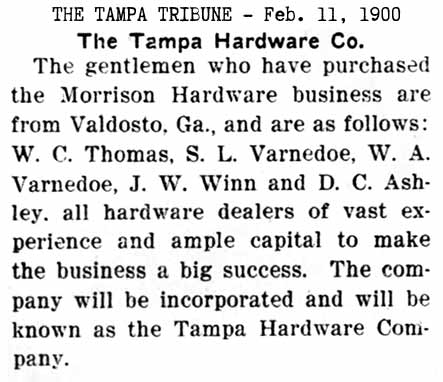 |
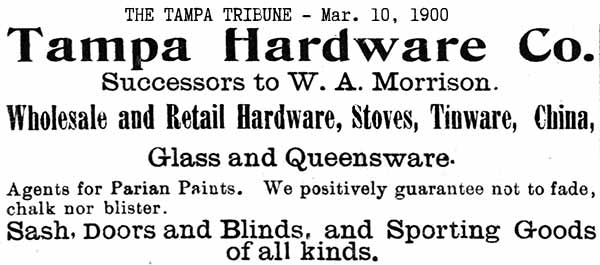
For almost a
year, Tampa Hardware carried the line
"Successors to W. A. Morrison" on their ads.
|
DETAILED SECTIONS OF
THE 1898 COURTHOUSE PHOTO PROVIDED
BY FLORIDA MEMORY - THE STATE LIBRARY AND ARCHIVES OF
FLORIDA

The ornaments on each skylight of the
dome were lightning arrestors.
Although the dome appears to be made of brick, the
exterior was actually tin plates.
According to Sanborn maps, the dome was "tin clad"
in 1903 but "iron" in 1915.
Iron may have been a reference to the supporting
structure, as an entirely iron dome would be
extremely heavy.
No article referring to anything other than
repairing or painting the dome has been found.

DIAMETER OF THE DOME DETERMINED FROM PHOTO AND
SANBORN MAPS
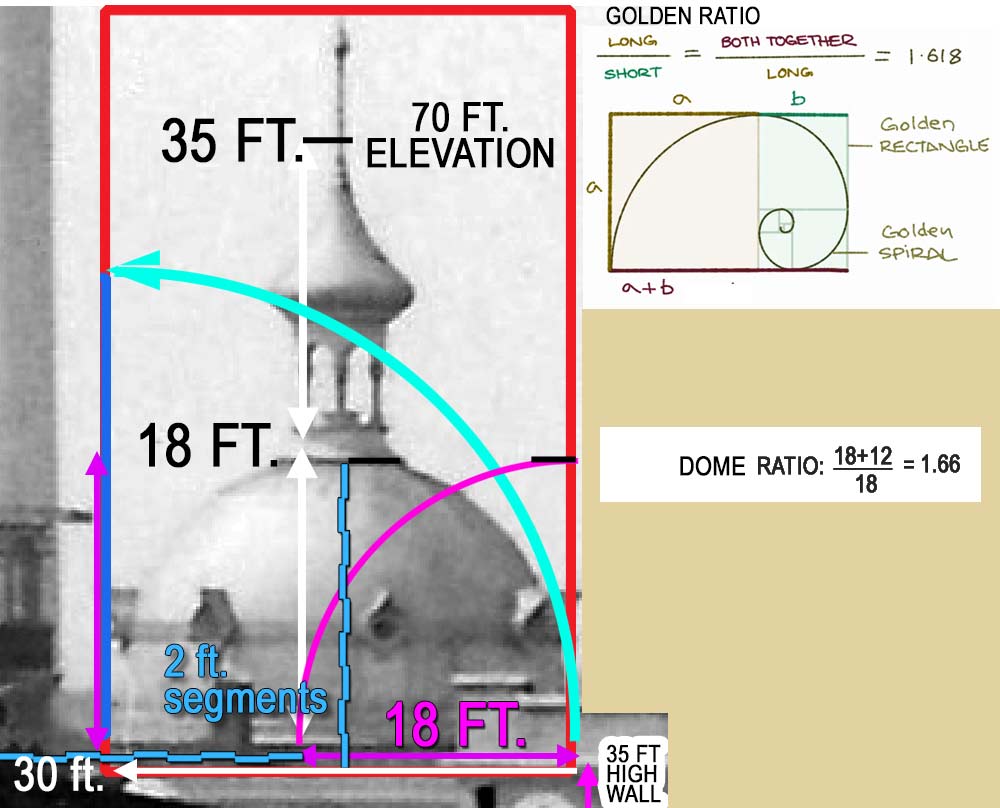
Approximately 30 feet in diameter.
|
THE
COURTHOUSE DOME/ROOF IN THE NEWS |
|
1895-Mar-06 |
County commissioners
Drawdy, Somerville, Brandon,
Vanlandingham & Harrell met. Among items
addressed was to have the courthouse
dome repaired, for which Chairman Drawdy
was authorized. |
|
1895-Mar-10 |
Tribune article writes
"Chairman S. J. Drawdy is having the
court house dome varnished.
Yesterday Harry Lucas was turning
summersaults on the spire in competition
with the weather vane. County
expenses paid the following month show
it cost the County $50. |
|
1896-May-23 |
Tribune article writes
"The court house dome will receive a new
coat of paint next week. |
|
1899-Nov-29 |
The searchlight of the
steamer "Margaret" furnished a beautiful
illumination of the dome last night that
was greatly enjoyed by those fortunate
enough to witness it. |
|
1900-Jan-31 |
Repainting the roof has
begun, the dome will not be painted at
this time, but commissioners may
authorize a steel ceiling installed in
the main courtroom in place of
re-plastering the present cracked one. |
|
1901-Jun-16 |
"Unless the badly cracked
dome is speedily fixed, something of
considerable more weight than the
average legal opinion is going to drop
on the Hillsborough County Bar. |
|
1901-Jul-13 |
Tribune article writes
"The court house dome ought to be
repaired at once." |
|
1918-Jan-11 |
Sixty-two foot tall steel
flagpole installed on lawn near the
Confederate monument replacing
"dilapidated bunting floating over the
dome which has been of late nothing but
an unrecognizable rag. See article
"Treat Flag With Proper Respect." |
|
1921-Mar-22 |
Bids being accepted for
painting of the dome, to be received and
opened on Apr. 1, 11 a.m. Address
all bids to Chairman C. T. Friend. |
|
1927-Nov-19 |
The "antiquated
courthouse" to have a little "brushing
up," to be painted at the suggestion of
Chairman W.T. Williams.
Commissioner John T. Gunn suggests
something other than the present dirty
gray. |
|
1927-Nov-23 |
Tribune article legal
notice: Sealed bids were being taken by
the Board of County Commissioners until
Dec. 9, 1927, to have the court house
dome and cornices painted. A
certified check in the amount of $100
was required with each bid. Plans
and specs for paint to be used was on
file in the County Commisioners' office.
Address bids to W.T. Williams, Chairman. |
|
1934-Apr-06 |
Hammering by FERA workers
on the dome causes interruption of
witness testimony in the Bruce murder
trial, Judge Parks calls out to bailiff
"That hammering will have to stop before
the trial can proceed!" |
|
1934-Jun-29 |
FERA work resumes on
unfinished dome. |
|
|
|
| |
|
| |
|
| |
|
|
The original pavilion
or "band stand" had electrical power, as evidenced
by the two power lines connected to the slats along
the cornice work.
|
This close up of the
courthouse windows shows they were more ornate that
just a plate of glass.
|
|
 |
 |
|
THE NEW COURTHOUSE CLOCK

Not exactly a town clock, it
was a wall clock, "thoughtfully put up
yesterday for convenience of the public by
Clerk Galvin.
THE CONFEDERATE
MEMORIAL, 1911
The history of this monument is presented here ONLY as
a history of a piece of outdoor art, nothing more. It is NOT a condemnation
or glorification of what it may mean to anyone of any
race, religion, culture, heritage, or ethnicity. The
topic of this piece is for the purpose of
revealing the facts of when and where
various events concerning it took place,
such as its planning, placement, damage and
relocations. |
|
FROM "The
Florida Public Archaeology Network"
Memoria In
Aeterna Hillsborough County Courthouse grounds.
Memoria In Aeterna
was erected by the United Daughters of the
Confederacy on the grounds of the old Hillsborough
County Courthouse in downtown Tampa, on February 8,
1911. It was relocated in 1952 upon completion
of the current courthouse building. A state
historical marker about this monument was placed at
this site in 1997 following the 1996 restoration of
the monument.
This monument is rich with symbolism, but the most
profound elements are the two figures of a
Confederate soldier--perhaps the same soldier--on
the north and south sides of this monument. On the
north side,** marching north to battle, is a young
Confederate soldier who is confident in his mission
and well equipped and walking proud. This soldier
sports a wide brimmed hat and blanket roll and has
musket at shoulder. On the south side, this same
solider returns home, hat in hand, head bandaged,
uniform in tatters, and using his musket as a cane
or walking stick.
**At
Court House Square, the
monument's soldiers didn't face north and south, they
faced closer to east and west (more accurately,
ESE and WNW) as Tampa was originally surveyed at about
23.5 degrees counterclockwise from north. When
moved to the new courthouse at 419 Pierce, they did face
North/South.
|
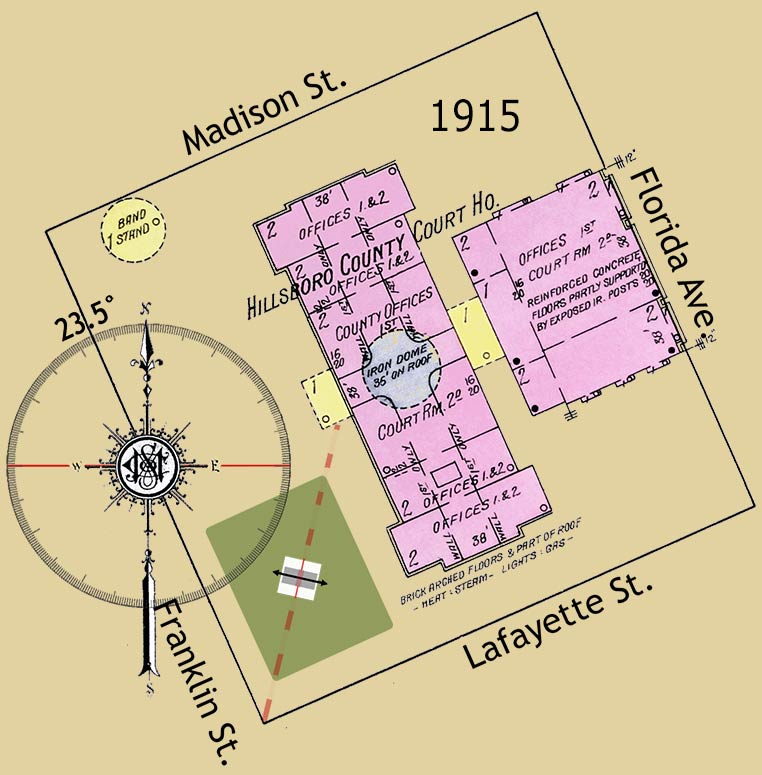 |
|
MONUMENT ANNOUNCED - 1910 |
The soldier
statues on the monument did not face north
and south, they faced closer to
east/west--or more accurately,
east-southeast and west-northwest. |
|
In 1910 the
local chapter of the United Daughters of the
Confederacy organization was given
permission by the County Commissioners to
erect a 19-ft tall monument in court house
square. Funds were raised and the UDC
was allowed to
chose where on the square to install it.
The
monument is basically an obelisk with
soldiers on a pedestal on opposing faces.
The confederate battle flag is depicted on the
front of the work and the dates 1861 and
1865 refer to the beginning and ending of
the Civil War. The poem on the
reverse side was written by Sister Esther
Carlotta, a Roman Catholic nun who was
president of the Florida Division of the
United Daughters of the Confederacy in 1911.
On one side of the obelisk is depicted a
Confederate soldier going off to war,
rifle on his shoulder, wearing his hat.
On the other side is a Confederate soldier
returning home in a
tattered uniform, head lowered and bandaged, his hat in
one hand, rifle held in the other hand as if
being used as a cane. |

RELOCATION AND DAMAGE
From its creation to its
current location, the monument was moved
twice, one soldier on the monument would be
vandalized, destroyed, replaced and then
redamaged. The other soldier was either
vandalized or damaged once, but exactly when
has not yet been determined.
|
|
This article below says that one of the figures on
the monument was to be a soldier, and the
other a sailor. No other allusion to
this has be found in later descriptions of
the monument and was probably a
pre-unveiling rumor. |
Below: The program for the
unveiling ceremony. Schools were
closed so teachers and students could attend
and participate. The main speaker at the
assembly before the unveiling
was State Attorney Herbert S.
Phillips. The article says "Mr.
Phillips is an able and forceful
speaker.." |
 |
 |
|
| |
|
|
READ THIS WARNING
The ceremony at the theater
before the monument unveiling was pretty
much a pro-Confederacy rally. The speech
made at the theater by the keynote speaker
"Hon." H. S. Phillips expresses racist
views. Lincoln abolished
slavery but unfortunately it did not rid Tampa of its ugly
white supremacy attitudes.
This website and its
owner do not ascribe to the opinions or
philosophies expressed in the article.
They are presented here ONLY as
a matter of historic significance as it
relates to Tampa's past. If you cannot
accept this as anything but the
uncensored account of a big part of Tampa's
history then
it is highly suggested that you don't read it.
By
clicking the excerpt below to read the
whole article you acknowledge that you have
read and understand the above. When the
article opens, click it again to see it full
size. -- TampaPix

|

The Greeson Theater was
Tampa's first posh, high-capacity theater.
It opened in 1910, but by the time is this
photo, it was no longer used as a theater.
Read about the Greeson, its owner, its
construction. design and demise, and see a
much larger photo with much more detail.
Here at Tampapix.
 |
|
In March 1911 the County
Commissioners voted to donate $500 to the
UDC to help them defray some of what was
still owed on the monument.
 |
|
HISTORY REWRITTEN - HORTENSE
OPPENHEIMER and the CITY HALL
CLOCK
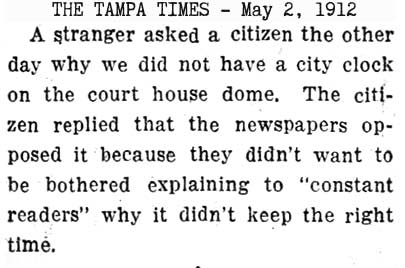 You've probably
encountered one of these stories about
Hortense Oppenheimer and her
efforts to fund a clock for city
hall: You've probably
encountered one of these stories about
Hortense Oppenheimer and her
efforts to fund a clock for city
hall:
In 1914, the socialite
daughter of prominent Tampa
physician Louis Sims
Oppenheimer, was dismayed
that Tampa had no municipal
clock. The Oppenheimer
children, five daughters and
a son, were no less vigorous
or gifted than their father.
Growing up in a world filled
with fine books, music and
sober industry, they found
it easy to share and emulate
their father’s
accomplishments.
Or
this one:
Miss Oppenheimer became
incensed at the city fathers
in 1915 because the new City
Hall had no tower clock to
give the proper time. The
City determined that they
were too poor to afford
clockworks for the clock
tower. Miss Oppenheimer
launched a campaign to fund
one. Her organization, "Ye
Town Criers", raised $1,200
by sponsoring various
entertainments. Their
efforts fell somewhat short,
but were successful in
raising enough money
privately to have the W.H.
Beckwith Jewelry Company
donate the remainder and
provide a 2,840 pound,
four-faced clock.
Or
maybe you've heard some
combination of the two.
Unfortunately, neither is
completely correct, in fact,
much of both of them is
incorrect; a romantic tale woven
over the years.
It it really didn't happen the way
ANY of the current "legends" go.
Find out how it really happened
here at TampaPix
|

The Oppenheimer
kids: Hortense, Irma,
Olive, Dorothy,
Louis N. &
Carmen, at their home in 1919.
Burgert Bros. photo courtesy
of the Tampa-Hillsborough Public
Library System. |
1913 Burgert Bros. photo below courtesy of
the University of South Fla. Digital
Collections
An elevated view of Franklin Street looking
north.
The building which appears unfinished seen
immediately to the left of the dome was the
new Hillsboro Hotel. The south face
was built practically without windows
because the next phase was to expand it even
taller on the south end.
 |
The building under construction in the
distance is the Citizens Bank tower at Franklin and Zack
Street.
At the time of this photo, the bank occupied the
building directly across Franklin St seen here with the
conical roof and flag on its corner tower.
Twomey's was located in the American Bank building which
would later be occupied by Maas Brothers.
Below is a crop of the above photo,
1913 Burgert Bros. photo below courtesy of
the University of South Fla. Digital
Collections

The intersection of Franklin & Madison streets; horse &
buggy carriages, streetcars and automobiles all shared
Franklin St. in this era.
Below is a crop of the same
photo,
1913 Burgert Bros. photo below courtesy of
the University of South Fla. Digital
Collections
The facades of Beckwith Jewelry and the First
National Bank building illustrate why the term
implies what it does today. From Merriam
Webster:
Facade is thought to have
come to English from the Vulgar Latin facia,
meaning “face.” Along the way it passed
through both Italian, as faccia, and French,
as façade. The earliest meaning of the word
in English was in reference to the front
portion of a building, it’s “face,” so to
speak (and face itself is sometimes used to
describe this part of a structure as well).
Somewhere along the way facade took on a
figurative sense, referring to a way of
behaving or appearing that gives other
people a false idea of your true feelings or
situation. This is similar to the figurative
use of veneer, which originally had the
simple meaning of a thin layer of wood that
was used to cover something, and now may
also refer to a sort of deceptive behavior
that masks one’s actual feelings (as in, “he
had a thin veneer of politeness”).
The Court Arcade seen at lower
left of the photo was the entrance to a long,
narrow space that went all the way to Tampa St.
On the south side of its narrow corridor were
spaces for businesses to rent. It also had
a long, narrow restaurant at the Tampa Street
end. The cropped Robertson-Fresh 1939
photo from the USF Library shown below give a
glimpse of roof of the arcade.

|
 |
William H. Beckwith
BECKWITH JEWELRY
Tampa City Council
Mar. 9, 1894 – Mar. 8, 1895
Mar. 8,
1895 – Jun. 5, 1896
Jun. 5, 1896 –
June, 1898
William H. Beckwith was born in
Greenville, Georgia on July 18, 1856. He
arrived in Hillsborough County in the
1870s, settling in Valrico where he grew
and sold oranges. He moved
to Tampa in 1886 and entered the real
estate business with former City Council
members--first partnering with Silas A.
Jones and later with William Benton
Henderson. |
|
Beckwith
was also a jeweler
and had his shop on
Franklin St. across
from Court House
Square.
As the
local Seth
Thomas clock
dealer, he
ordered Tampa's
1915 City Hall
clock from Seth
Thomas Tower
Clock Co., sold it
to the City,
supervised its
installation,
and maintained
it in the early
years.
He was
also
involved
with
automotive businesses He was
a charter member of Ye Mystic Krewe of
Gasparilla and the Tampa Yacht & Country
Club, which were both founded in 1904.
Beckwith served three consecutive terms
on Tampa’s City Council, participating
in the Finance Committee, the Wharves,
Bridges and Harbors Committee, and the
Schools and Public Buildings Committee.
He died on September 1, 1926.
|


Burgert Bros. photo below courtesy of the
Tampa-Hillsborough Co. Public Library Cooperative.
A horse drinks water from the fountain on the north end
(Madison St.) of the courthouse square, 1912.**


**This photo is probably closer to
1913-1914. In the background can be seen the Hotel
Royal. In late 1911 to early 1912, J. L. Tallevast of
Manatee Co, along with his partners, (The
"Hillsboro Hotel Company") began construction on an
8-story concrete, steel and fireproof plaster hotel on
the north side of the predecessor to the Royal, the
original Hillsboro Hotel of Maj. Wright. In Aug.
1912, Wright leased the old 3-story Hillsboro to George
D. Kronenberg of Tampa, who would renovate it and
operate it under the name of the Hillsboro Hotel Annex,
to be opened around Oct. 1. In late Feb. of
1914, Tallevast awarded a contract to McGucken & Hyer,
to expand the newly built (at Twiggs and Florida Ave)
Hillsboro as planned on the south end. The
design was being drawn by architects Bonfoey & Elliott,
but the construction had to wait until April 1915 when
the lease ran out on the old Hillsboro Hotel Annex,
which was then operating as the Royal Hotel.
Below: Close up of the original
pavilion/band
stand and the entrance from above 1913 photo.
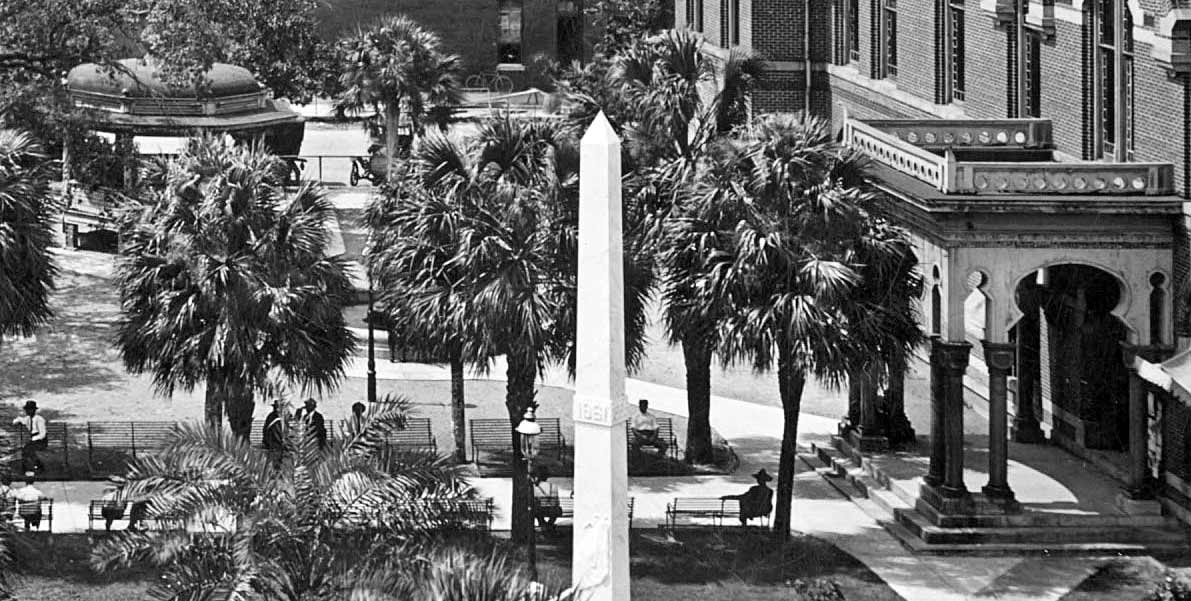
Burgert Bros. photo below courtesy of the USF digital
collections.
This photo is from no later than 1919. Evidence of
this can be seen immediately to the right of the
courthouse annex--the Hillsboro Hotel. From 1916
to 1919 it it appeared as seen here. In 1920 a
9-story addition to match the existing tower was built
adjacent to it on the west side (left.)
Mouse-over the photo to see the first two phases of the
Hillsboro Hotel marked in yellow and blue.

The
"double building" seen over the courthouse was the
Citizens Bank at Franklin & Zack streets. In
1925, two more stories would be added to the top "crown." At extreme right is
seen the edge of the Elks Club building, which would not be visible
after the Tampa Terrace Hotel was built on the near
corner of the block. (1924.) Compare to
the photo below from 1921 where can be seen the 3rd
phase completed--the top of the
Hillsboro's twin west annex. (More about the
Hillsboro on the next page.)
COURTHOUSE FLAG IS A DISGRACE
By
Jan. of 1918, the
flag was a dirty,
tattered and torn
old rag, and the
Board of County
Commissioners got an
earful from plenty
of Tampans. about
it.
The Tampa Times
reported on Jan. 8,
1918, that "The
board has suffered
some reproach for
the apparent neglect
of the flag in
leaving it to flap
on the roof of the
dome in a
demoralized and
ragged condition
The board was not so
much to blame.
A difficulty with
the halyards made it
impossible to raise
or lower the flag,
and a suggestion
that one of the
members climb the
staff and rectify
matters was not
received with
enthusiasm, the
member admitting he
was much too portly
to become a human
fly."
It was described as
"...the dilapidated
piece of bunting
floating over the
courthouse dome,
which has been of
late nothing but an
unrecognizable rag.
The winds and storms
and Florida sun have
beat upon it and
whipped and faded
it, until it has
become too
disreputable for
further use.
A new flag, seven
feet long, was
purchased and a
62-ft. tall flagpole
consisting of
galvanized iron pipe
we set solidly in
cement eight feet
deep on the
courthouse lawn near
the Confederate
monument. The
flag was to be
raised at sunrise
and lowered at
sunset by "old
Jacobson" the
courthouse janitor.
The earliest photos
of this courthouse
show the weather
vane, but no photo
has been located
showing a flag
flying from the
spire.
1921: Buses filled with
tourists, parked in front of the court house annex on Florida Avenue. It
appears that the annex had not yet expanded on the north
end to the corner of Madison St. and Florida Ave.
This is what guests at the Tampa Terrace Hotel would see
in 1924..
Burgert Bros. photo courtesy of University of South Fla.
Digital Collections.


Close up of the buses from the above
photo.
|
Three elements in the
Burgert Bros. photo below from the Florida
Memory State Library and Archives of Florida
below place this photo in the 1920s.
At upper left can be seen the double towers
of the Hillsboro Hotel, the leftmost one was
completed in 1920. The lack of an
attractive hedge around the base of the
monument and the four relatively
small, un-sculpted shrubs surrounding the
monument, and the good condition of the
courthouse window canopies indicate early to
mid-1920s. |
The 1926 photo
below shows the courthouse annex had been extended to the
corner of Madison and Florida Ave. by this time.
Burgert Bros. photo courtesy of the THCPLC. |

|

Notice in the
photo at left the slight forward-leaning
posture and rear placement the left foot of
the original "marching to battle" soldier on the left.
This probably contributed to its demise in
1946.
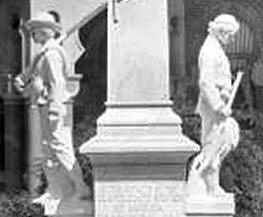
 |
1935 Burgert Bros. photo below
courtesy of the USF digital collections.
Taken from the top of the Bay View Hotel.

Notice immediately below the Tampa
Terrace Hotel sign that the courthouse annex had also
been extended to Lafayette St. on the south.
Below: July 15, 1936
Burgert Bros. photo courtesy of the THCPLC.

This photo, taken from the Bay View
Hotel, shows the annex behind the
courthouse had also been expanded sometime from 1931 to
1936 to the south making it symmetric. The 1931
Sanborn map shows this had not yet taken place.
1938, the dome of the
courthouse and the tower of City Hall,
Burgert Bros. photo courtesy of the THCPLC.


UNCLE SAM SHARES
THE PLUNDER - THE CAPTURED WW1 GERMAN GUN
Visible in the above
photo is the WW1 monument
consisting of a captured German gun on its 2-wheeled
carriage. At right, the State
Capital has acquired a captured German gun for
display on the grounds in front of the Parkhill
monument. Plans were to move it to a permanent
place as soon as one was prepared.

AT LEFT: The War
Dept. had pieces of captured German field artillery
available for communities to display as monuments,
or use for national guard, if possible.
machine guns, howitzers, trench mortars, rifles,
bayonets and other items. Interested
communities were to contact the War Dept. in
Washington D.C.
It hasn't been determined yet as to
when it was obtained, or the circumstances, but the
article at right describes a similar acquisition for
the state capitol in 1919 at Tallahassee.
See upcoming article by Leo Stalnaker, Jr. in 1946
to learn what happened to the gun. A drinking
fountain is also visible in these photos.
|
|
Below: Enlargement from the
1937 photo which follows below this one.
 |
Below:
Enlargement from above 1939 photo. |
|
|
In March 1926, Dade
City acquired a "76mm minnewerfer with wheels"
|
|
 |

AT
LEFT: This June 1921 photo shows the German gun had
not yet been placed on the courthouse square.
Compare to virtually identical view from 1937 below.
Photo
courtesy of the Tampa-Hillsborough Co. Public
Library System. |
|
Below is a crop of a much larger
Robertson & Fresh undated photo courtesy
of the University of S. Fla. Library
digital collections.
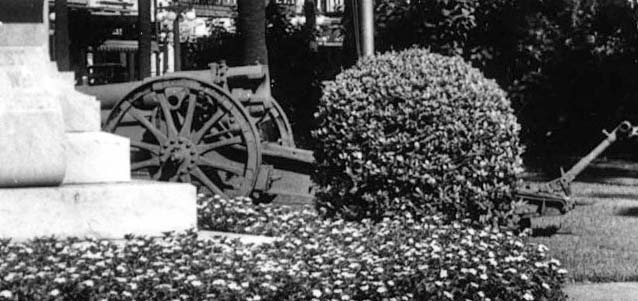
This side view shows the
length of the towing carriage.
Barely visible in the uncropped photo
are a couple of cars which appear to be
late 1920s to early 1930s.
BELOW: This beautiful view of
City Hall, the Confederate monument, and the WWI
German gun is a Burgert Bros. photo from
the Tampa-Hillsborough Co. Public Library System.
It is dated Oct. 1937. Ten year later,
the soldier marching to battle would be M.I.A.
(Missing in action.) |

The sign to the
right of the tree trunk indicates the landscaping
was done by "Garden Gate Circle."
This was a beautification project started by the
Tampa Garden Club in 1932.
|
 |

 |

Cropped portion of Oct.
1937 photo above courtesy of the
Tampa-Hillsborough Co. Public Library
System. |
|
 |
THE WORLD WAR II TEMPORARY MEMORIAL
|
|
Even
before World War II was ended, Chairman
of the Hillsborough Co. Defense Council,
Howard Macfarlane, obtained permission to
build a memorial to honor the war's
casualties from Hillsborough County.
It was to be a temporary one until the
war was over an all the names could be
collected for it.
 |
 |
So many fresh flowers were being placed inside
by visitors that they often obstructed the names
which were near the bottom of the plaques
inside.
Furthermore, the flowers would wilt and die and
be left inside to decay and become an unsightly
mess. The solution was to assign
responsibility of clearing out the old flowers
and supplying fresh ones to groups already
desiring to participate. The Garden Gate
Circle of the Tampa Garden Club also
participated with flowers and planting shrubs
around the memorial.

|
CONFEDERATE MEMORIAL VANDALIZED, RIFLE STOLEN
In early Oct. 1945,
some "Yamdankee" stole the entire rifle off the shoulder of
the hat-wearing "marching to battle" soldier. Later articles in the
Tribune would refer back to this event, but the
writers would have a poor concept of how long ago it
was and what the circumstances were.
LEO
STALNAKER, JR. HAS HAD ENOUGH
In this March 1946
article below by Leo Stalnaker Jr., son of the
controversial Tampa judge of the same name, the
neglect and intentional defacing of Tampa's war
memorials is brought to light.
-
The temporary WWII monument
was being used as a
convenient "out-house" by drunks
at night.
-
The small
marble obelisks which were spaced out
each mile on Memorial Highway, at the
time was Grand Central Ave.
eastward from Howard Ave.
The main monument was located at
that intersection when first
dedicated, but was moved to the
American Legion cemetery because cars kept running
into it. A twin monument was
located in the median where
today, Kennedy Blvd. curves
northward to Memorial Hwy.
Read more about this monument
and dedication ceremony for Memorial
Hwy "The road of remembrance" here at TampaPix.
-
The
Spanish-American War monument on the grounds of the
University of Tampa in Plant Park which at the time had become only the
concrete base because the original Fort Dade gun had
been donated for scrap metal during WWII (even
though junkyards were piled high with scrap.)
See
photos of the original monument
with the actual Fort Dade gun.
-
The theft of the rifle from one
of the soldiers on the
Confederate monument, "more than a year ago,"
[it had only been 5 months] leaving the soldier in a "brother can you spare a
dime" pose.
|
|
Not
pictured but mentioned below: The monument of
WWI--the captured German gun on a wooden
carriage which had rotted away causing the piece to
fall to the ground. The only wood
that could have rotted was the inner
rims and spokes of the wheels. |
 |
 |
Read more about
the Spanish-American War Memorial at Plant Park,
and see photos of the original Fort Dade cannon
as well as the one now on display.
Here at TampaPix.
|
CONFEDERATE MEMORIAL DAY, APRIL 26, 1946
- RIFLE WAS ALREADY MISSING
|

This event was
covered without mention of the
unarmed soldier of the monument.
Mention is made of Joseph Paul Robles,
age 99, one of two of the last Civil
War pensioners of Florida still
living. He was a son of Tampa
pioneer Joe Robles, whose Civil War
service is best remembered by his legendary
capture of Union Soldiers by
creating the illusion of being a
whole company of soldiers. He in
fact was by himself, and he had
run out of ammunition. Read
more here at TampaPix:
The
Courage of Joe Robles
THE UNARMED SOLDIER IS TOPPLED
Had
Stalnaker waited several more months
to write his article, he could have
written about the destruction of one
of the statues, which, even
before finding the culprit, was immediately
thought to be intentional vandalism
and a strike against the
Confederacy.
The
article by Juanita Green below
incorrectly mentions the theft of the rifle from
the monument "Last April when the
Chapter went to lay a wreath at the
base of the statue they discovered
it standing empty-handed."
The truth was the
ceremony for 1946 consisted only of
the ladies laying the wreath, and the rifle
had already been missing for several months
at that time.
Fake
news is highlighted in yellow.
The UDC women were fully aware of
the missing rifle. |
 |
|
THE UDC GETS THEIR MAN, WANTS
NAVY TO PAY FOR THE DAMAGE
 |
On Oct. 29, 1946, Dominick
Berardinelli, age 20, was assessed a $300
fine for breaking the statue. He
testified it was an accident, and he did not
intend to break it. He said he and his buddies
were clowning around in the courthouse
square when he climbed the monument to get a
closer look. Berardinelli came forward
on his own to confess to the act, and his
fine was paid by his commanding officer.
Notice Judge Potter's
concern, "Was anything said against the
Confederacy?" "NO SIR, we were ALL for
it!"
After the trial,
Berardinelli repeatedly expressed his
regret, but also added that the statue
wasn't bolted to the monument, "but is
should be. It might have fallen on
some child playing around it." |
|
 |
Below, a rare view of the
courthouse showing the Confederate memorial without the
"marching to battle" soldier on the left.
1946 to 1949 Burgert Bros.
photo courtesy of Florida Memory, State Library&
Archives of Florida.

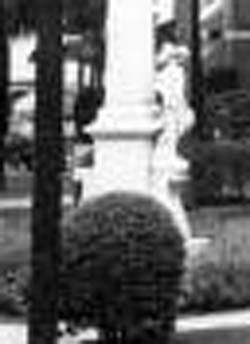
Also visible is the
overgrowth of ivy on the south wall of the building but
not so much on the front facade.
1947
Burgert Bros. photo courtesy of the THCPLC

The new temporary memorial can be
seen behind the trees at the right below City
Hall.
RESTORED
CONFEDERATE MONUMENT UNVEILED, WITH RIFLE
It
would be nearly three years haggling Congress to pay
for the damage before the broken memorial was fixed
with a new statue. It was through the efforts
of these ladies that Congress appropriated $1,000 to
replace the statue destroyed by Berardinelli.
Though it is not mentioned in the article, the replica
statue was created with a shouldered rifle, as the
original was. (Post-1946 photos bear this out.)

|
THE
END IS NEAR FOR THE MAJESTIC OLD COURTHOUSE
|
|
 Plans for a
new courthouse were started in 1946, spurred
by downtown parking
issues in the latter half of the 1940s.
No articles were located regarding any
structural or maintenance issues with the
building. One source, which TampaPix
is attempting to relocate, said the south
wall collapsed one night due to moisture
seepage caused buy the flourishing ivy. It's safe to assume there
were space issues by this time, even with
the annex which was built before 1915 and
expanded before 1926. There was likely
the need for larger courtrooms, more
offices, etc, The topic of traffic was
brought up in response to talks of building
a "skyscraper" courthouse at the same site.
The downtown merchants as well as the police
chief were against building
larger at the same site, they wanted it out
of the central downtown business district
altogether. Plans for a
new courthouse were started in 1946, spurred
by downtown parking
issues in the latter half of the 1940s.
No articles were located regarding any
structural or maintenance issues with the
building. One source, which TampaPix
is attempting to relocate, said the south
wall collapsed one night due to moisture
seepage caused buy the flourishing ivy. It's safe to assume there
were space issues by this time, even with
the annex which was built before 1915 and
expanded before 1926. There was likely
the need for larger courtrooms, more
offices, etc, The topic of traffic was
brought up in response to talks of building
a "skyscraper" courthouse at the same site.
The downtown merchants as well as the police
chief were against building
larger at the same site, they wanted it out
of the central downtown business district
altogether.

This was a
1948 publicity event with Weeki Wachee
mermaids to promote a film titled "Mr.
Peabody and the Mermaid."
Photo courtesy of Florida Memory, State
Library and Archives of Florida.

Image courtesy of Wikipedia
THE NEW COURTHOUSE In the latter half of the 1940s a decision was reached to
build a new complex on the east side of
Pierce St. between Lafayette & Twiggs
streets by cutting off Madison St at Pierce.
It currently ran about a block past
Jefferson before it dead-ended.
A decision had to be made whether to
move the temporary WW2 memorial to the new
courthouse as soon as possible or build the
permanent one instead. There was also
a drinking fountain and a display fountain
along with a goldfish pool to consider.
The moving of the Confederate memorial would
require more planning since it was so heavy
and fragile. This stirred up another
hornet's nest with the UDC. |

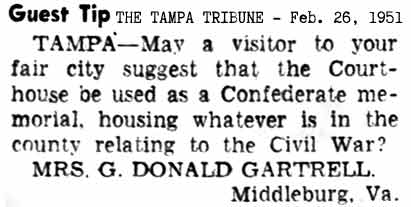
OLD COURTHOUSE SOLD TO
NY DEVELOPERS FOR $800k
Mrs. Finlay Hunter
and other members of the UDC were at work
trying to persuade lawmakers in Tallahassee
to preserve the old building and keep the monument right
where it was. But the House said it was a matter
for the commissioners to decide.
In Jan. the next year,
the county commissioners' offer to sell the courthouse
was accepted by a New York property investor. The
plan was for them to put $100k down, then another
$200k when the property was turned over to him.
The rest would be paid under mortgage of 2.5%. The
price was TEN times what it cost to build it in 1891.


The UDC claimed,
"They promised they would never move the memorial
without giving us notice, they haven't written a letter
to us in the first place. The UDC has not given
permission that the memorial be moved and we don't think
they have any right to move it. It was dedicated
as a permanent memorial on public property and the
property belongs to the citizens of Hillsborough County,
not the commission."

This enlargement below of
the above photo indicates that by this time in 1952,
the barrel had been broken off above the hand from the
"homeward bound" soldier on the right.

|
The skyscraper deal fell through
with Weissman and Schaffer in mid-Feb 1952...
Click on the articles to read the rest of
them

...but almost
a year later a new offer of a lease with
option to buy was agreed on and the New Yorkers
came back to Tampa with a $10,000 down
payment check on the old courthouse site.
 |
While the
search for a buyer was once again being
conducted, the memorial was being prepped
for relocation.

Meanwhile,
many opinions as to what should be done with
the site were still being sent to the
Tribune.

Click the excerpt below to read the whole
article. |

UDC AND
PRESERVATIONISTS FILE SUIT TO HALT SALE AND
DEMOLITION
After a demolition
contract had been awarded, a group of
Tampans headed by Mrs. W. Finlay Hunter
filed suit to stop the sale and subsequent
demolition of the courthouse, hoping it
could be turned into a museum and public
recreation center. Their charge was
that the commissioners had no right to sell the
courthouse property and the monument without their
permission. The contract to
demolish had already been awarded to Tampa contractors
Sprinkle & Quinby who were the highest
bidders at $2600. Contracts for
demolition are awarded to highest bidders
because they get to keep anything they can
salvage from the property after the County
sold whatever they could and was removed by
the buyers.
JUDGE RULES IN FAVOR OF COUNTY
Circuit Court Judge Parks ruled in favor
of the County, they had the right to sell the property.
The two courthouses before this one had also been sold,
but they were bought by private citizens who had the
structure moved to a new site where it was repurposed.
The little old McKay courthouse from 1846 to 1854 was
bought by Jackson Redbrook who moved it nearby and used
it as a general store. Later it was moved again
and used as a warehouse by the Peninsular Telephone Co. The next courthouse after McKay's is credited to its builder John H. Breaker and
was used from 1854 to 1891. When it was sold, it was moved up Fla.
Avenue between Polk & Cass St. and used as a boarding
house for many years.
Nothing moves faster
than demolition in Tampa.


GREEN LIGHT GIVEN FOR DEMOLITION, THE COUNTY
WASTES NO TIME
Sprinkle & Quimby had been awarded the
demolition contract, but the lawsuit to prevent the sale
delayed the start. In order to guarantee that the
deadline would be met, the contracting company of Cone
Bros. was renting additional equipment to S&Q so there
would be no delays. The county commissioners cut a
deal with associated furniture dealers in Tampa,
allowing them to sell on site whatever furniture they
could remove from the old building. This would
include equipment and furniture fixed to the floor such
as jury chairs, counters and safes. Purchasers
were to remove their items from the premises without
delaying demolition.
|

Mar. 1953 Burgert Bros. photo below courtesy
of THCPLC
The abandoned front entrance.
 |

REPORTER MOCKS COURTHOUSE DEFENDERS
This Tribune writer belittles
those who wanted the courthouse spared and
repurposed. He refers to them as "the
impassioned defenders of the sanctity of the
ancient building" and expected to see "one
of the antique-minded good ladies rush up
and throw herself in front of the
bulldozer." He calls the building "the
old monstrosity" and refers to parts as
"horrible Moorish domes.." Then he
points out his superior intellect by
referring to a woman who "probably has been
mispronouncing 'RAZE' all her life" by
quoting her as saying "razzing." He
ends by referring to the building as one
from "the Middle Ages."
|
|
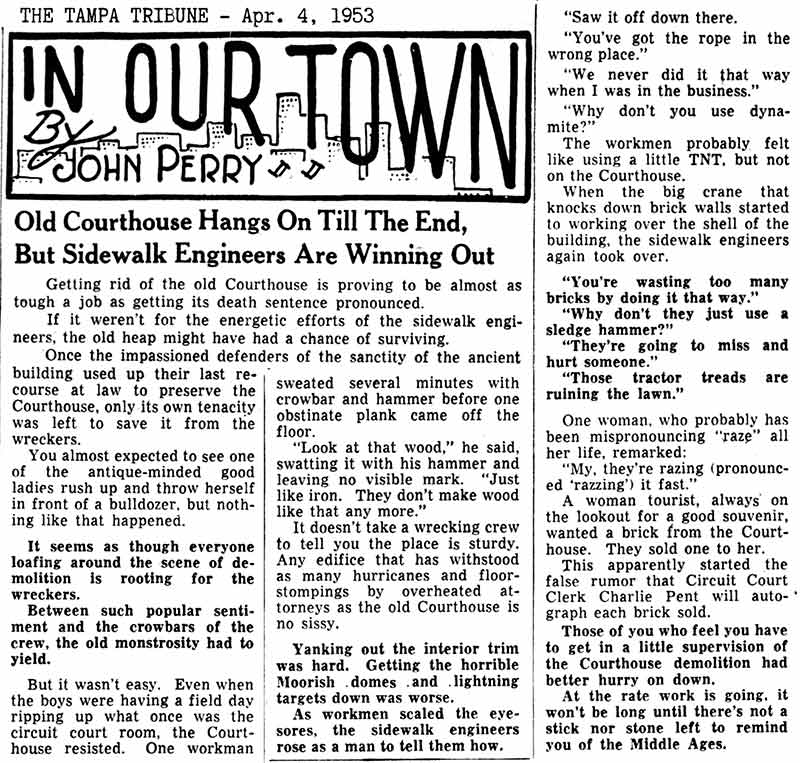 |
|
|
|
April 29, 1953 Burgert Bros. photo courtesy of the
Tampa-Hillsborough Co. Public Library Cooperative.
Mouse-over
the photo to zoom in.

Notice the salvaged materials for sale
stacked along the sidewalk of Florida Ave.
The tall building just to the right of Sacred Heart's
dome was the Peninsular Telephone building.
The building that wraps around the the south side of the
Sacred Heart church was the Jesuit school building.
In the distance at far left is the towering Floridan
Hotel, the tallest building in Tampa until the early
1960s when the Exchange Bank tower was built.

Crop of the courthouse demolition photo showing the
Jesuit high school building.
The front face of Sacred Heart church is blocked by the
Hillsboro Hotel at far left.
Also seen here at lower right is the Elks Club building
and just beyond it, the Western Union building.
|
Don't worry, he said, "we'll pave it so so
it won't be left in an unsightly, raw
state."
Burgert Bros.
photo courtesy of the Tampa
Hillsborough Co. Public Library Cooperative.
Weissman:
"But it's definitely not going to be a parking lot
for long."
|
 |
|
 |
So pave it they
did...
|
Sep. 17, 1954
|
And three
years later it was
still a parking lot on Dec. 5, 1957.
The tall building is the First National Bank
of Tampa, f.k.a. the Bank of Tampa. |
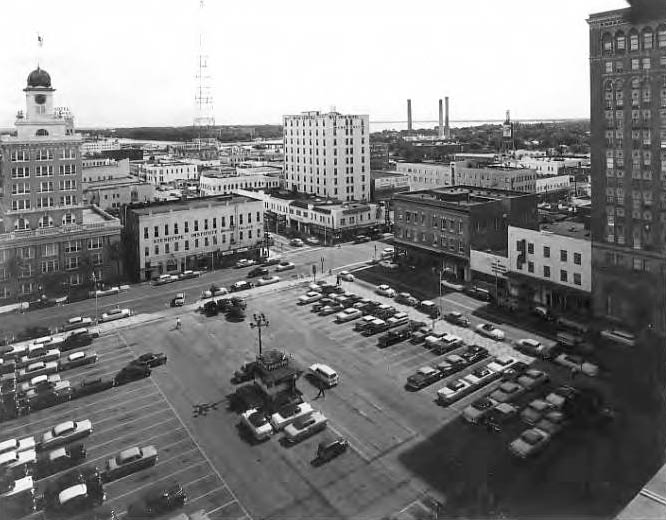 |
 |
|
Burgert Bros.
photos courtesy of the Tampa-Hillsborough
Co. Public Library Cooperative. |
The article below was a small part of a nationally
published article about various efforts around the
country to preserve old buildings and save them from
demolition, and relocation of various monuments.
The cartoon was part of the article; the inset on the
left and photo on the right were the only portions of
the article pertaining to Tampa.
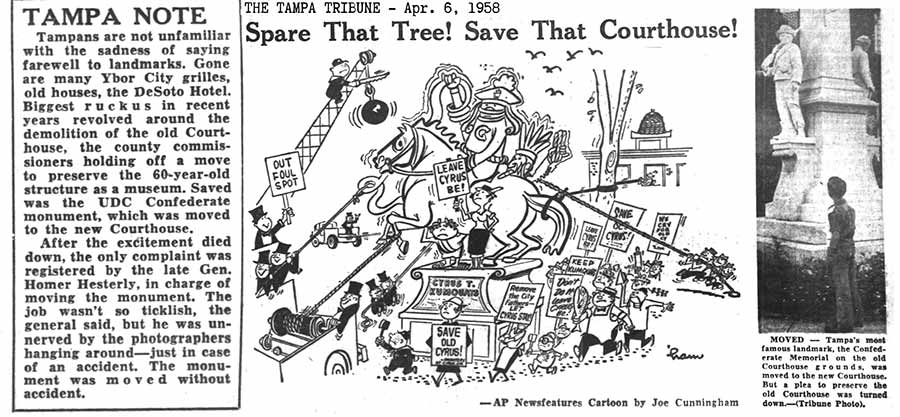

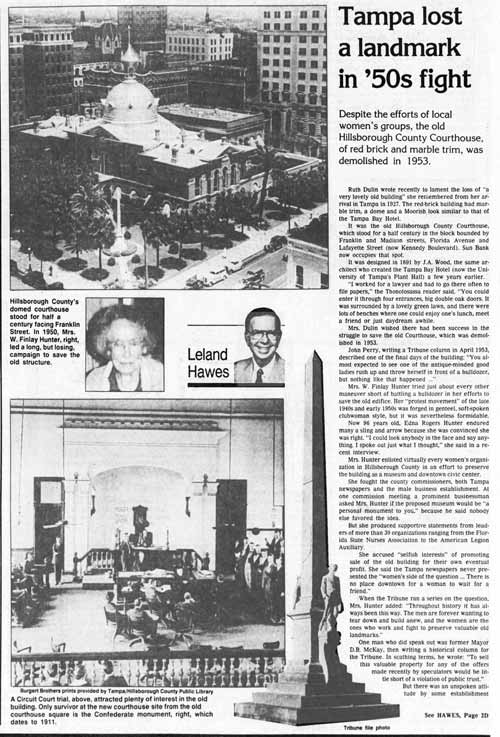
READ THE ENTIRE ARTICLE
by Tampa Historian/Journalist Leland Hawes.
It contains comments by
Mrs. Hunter and info from her file on her efforts.
It also tells about the
condition of the courthouse and what it would have taken
to overhaul it and turn it into a museum.
The article is split in
two images:
Part 1 of 2
Part 2 of 2
When they open, click them
again to see full size.
Click the image below to
read this 1996 Leland Hawes article about childhood
memories of what it was like going downtown in the old
days.
When it opens, click it again to see it full size.

|

CONSTRUCTION
OF THE NEW COURTHOUSE
The site for
the new courthouse was selected in 1948
which included the area outlined in yellow at
right. The south side of Madison St.
consisted mainly of James Madison Jr. High
School, marked in green.
The first
phase of construction was to close off
Madison St. at Pierce and Jefferson.
It already dead-ended at the next street,
East St.
Jul. 31, 1948 Burgert Bros
photo courtesy of
the
Tampa-Hillsborough Co. Public Library System
| |
|
|

Madison Jr.
High opened on time in October, 1915.

A new James Madison Junior
High School was opened in South Tampa on the
Interbay peninsula in 1952. The school
opened under the leadership of Earl Hatcher,
its first principal. . In 1992, Madison
Junior High became a middle school.
(The History of Hillsborough County Public
Schools, 1848-2000, Compiled by the
Department of Research and Development,
Supervisor Judith Lombana Ed.D., Author
Richard Bair, Ph.D. Author) |
At Left:
James Madison Jr. High School as seen from
Madison St. between Pierce and Jefferson
streets.
Sep. 16, 1922 Burgert Bros. photo
courtesy
of the
Tampa-Hillsborough Co. Public Library System
Construction
of Madison Jr. High School was completed in
Oct. 1915.

It
was demolished in June 1950.
 |

Construction
of a new county courthouse at Madison &
Pierce streets was started in 1950 and was
completed in 1952.
Mar. 16, 1951 Burgert Bros photo courtesy of
the Tampa Hillsborough Co. Public Library
Cooperative |
|
Dec. 2, 1952 - Robertson &
Fresh photo courtesy of the University of S.
Fla. Library Digital Collections.

The new
county courthouse seen from Lafayette and
Pierce streets.
1952 Robertson & Fresh photo from the
University of South Fla. Digital Collections
Looking east on Madison St.
to its end at Pierce St.

Nov. 20, 1952 Burgert Bros photo courtesy of
the Tampa Hillsborough Co. Public Library
Cooperative

This photo
also shows the "marching to battle" soldier with
intact rifle
resting on his right shoulder.
|
Work on the new, permanent WW2
memorial started in late 1952.
It was designed by local
architect Richard S. Himes to be
in similar style as the new
courthouse, and built by the
same builders of the courthouse,
Paul Smith Construction Co.
The plans called for
construction of concrete and
steel, the names of the war dead
inscribed on the outer walls.
Surrounding the building would
be a reflection pool, sidewalks,
and tropical shrubbery, and be
"monumental in design."
The inside would be designed to
house storage for garden tools
to be used in maintenence of the
courthouse lawn.
|
 |
At right: May 31, 1953 Burgert
Bros. photo
courtesy of the Tampa
Hillsborough Co.
Public Library Cooperative.
 |
 |
|
But what was
built seems to best reflect the
design of the courthouse was the
material. Emphasis looks
more like it's on the storage
capability, with little room for
reflection in the reflection
pool, and the names of the WW2
and Korean war dead inside the
monument. It was built at
a cost of $8,000. |

Hillsborough
County's memorial to the casualties of the
Trojan war? No, it's outdoor art that
conserves water.

BELOW: A
close up crop enlarged from the previously
shown Nov. 20, 1952 photo shows the
"marching to war" rifle still intact and the
"coming home" rifle barrel missing.
AT RIGHT:
April 27, 1964 - The shouldered rifle is
still intact. |
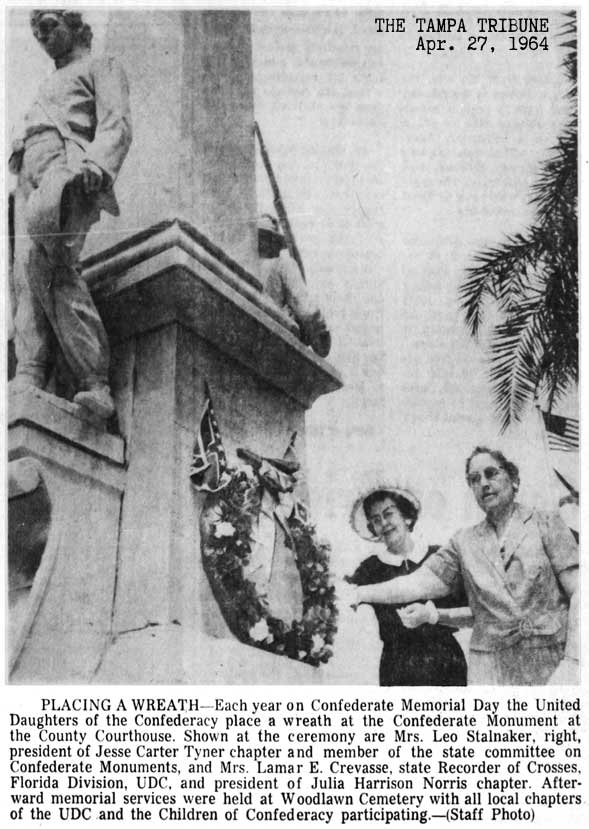 |
|
 |
CONSERVATION OF THE
CONFEDERATE MONUMENT AND ENSUING CONTROVERSY
In 1996 Hillsborough County collaborated
with the National Institute for the
Conservation of Cultural Property, Save
Outdoor Sculpture program, to address the
condition of the Confederate memorial sculpture. The
County completed a thorough cleaning and
conservation treatment, but did not
restore the broken rifles in order to
maintain the original integrity of the
historic piece. After the restoration,
a historic marker was placed.
The marker has a couple of
inaccuracies.
These photos were
taken in March 2009 by William Lees and are
presented courtesy of the
Florida Public Archaeology Network.
|
Shouldered rifle still missing |
Pretty close match to the
original seen here. Rifle
positioned slightly lower on his
shoulder.
Oct. 1937 photo of City Hall. |
Barrel of rifle still missing
above the hand. |
|

Photo by William
Lees courtesy of the
Florida Public Archaeology
Network. |

Crop of previously used Burgert
Bros. photo. |
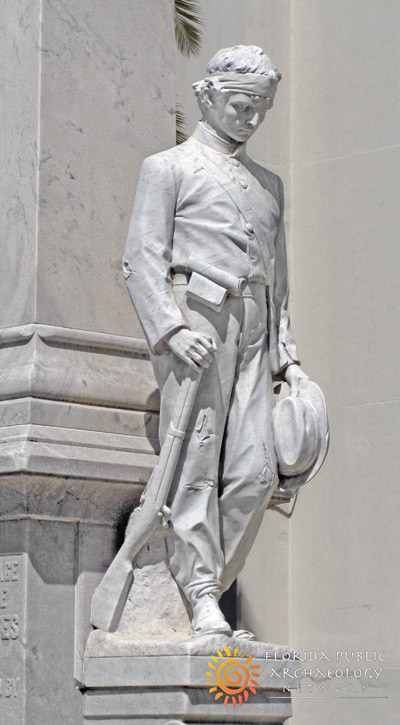
Photo by William
Lees courtesy of the
Florida Public Archaeology
Network. |
Historic marker
inaccuracies:
The monument was
on the NORTHEAST corner of Franklin and
Lafayette streets. It was on the
SOUTHWEST corner of the courthouse square.
It makes a difference if you are referring
to the intersection by use of the street
names, or by the plot or block it occupies.
The program was called "Save OUTDOOR Sculpture."
You can see larger images at the Florida
Public Archaeology Network where these
photos are from.
Photos by William Lees.


THE FINAL MARCH
The monument remained in front of the county
courthouse until the recent "Erase all
traces of the history of the
Confederacy" movement that was taking over the
country. After months of debate
beginning in July 2017, to appease
opponents of the monument, it was
moved at a cost of almost $300k to the
Brandon family cemetery at Brandon Boulevard
and Lithia Pinecrest Road. The
monument was gladly received by the
descendants of John Brandon, Confederate
veteran and namesake of the unincorporated
community. The funds were
raised in one day through large donations
mostly
from several influential corporations, local
sports franchises, and
Tampa VIPs. It took seven months from
the date of the county commissioners' vote
to get it prepped, moved, set up and dressed
at the new location in Brandon.
Unlike in front of the
courthouse downtown, where from some vantage
points it blended almost unseen in with the white
courthouse, it now stands more conspicuously
on one of the busiest roads in Hillsborough
County. It is estimated that about
130,000 cars a day drive that section of
State Road 60, according to the Florida
Department of Transportation.
Some think it's now being seen by many more
people because of its location on a busy
road.

Notice the
"politically correct" placement, so that only the returning
soldier faces the busy road. |
|

|
Photos courtesy of the Osprey Observer**
**About the photo credits by
photographer Nancy Nahas: The source
website's
caption of the above photo and a second one
incorrectly states "...The
Confederate soldier (left) is facing south
and the Union Soldier is facing north"
when in fact, both depict
Confederate soldiers. Yet, the article
in which the photos appear, and whose author
(Nick Nahas) may be related to the
photographer, quotes from the historic
marker which basically states both are
Confederate soldiers.
Click
the image to see the inscription on the
reverse side larger.
Image courtesy of Florida Public Archaeology
Network.
Photo by William Lees
Photo has been enhanced for contrast and
color correction for display here.

Read about the removal and relocation.
|
|
|
THE CHROME DOME
Today, a less detailed
and less ornate replica of the courthouse
dome glistens atop poles of a
seatless pavilion in Joe Chillura Courthouse Square at
the corner of Morgan and Madison streets.
Up until recent
years, Hillsborough County used an image of the old
courthouse roof and dome for its
logo.
Now a silhouette of the park
pavilion is used, so you might
say the old place has also been
demolished
symbolically as well as
physically.
|
 |
 |
 |
| |
|
|


This somewhat
surreal elevated Google view of the
courthouse shows how the courtyard was split
into two squares.
The drainage system and downspout for the
water reclamation "temple" can also be seen
here.
So what became of the parking
lot at the original Court House Square?
|
In 1961, construction began
on the north half of the property with the
new home of the Marine Bank. So
then it was only HALF a parking lot.

Both are Burgert Bros. photos
courtesy of the THCPLC.
And on the
north half of the block was
built this most ornate, highly
crafted work of art. It's
unique style of architecture is
called "HORRIBLE BLUE BOX."
And it is
still around today, as the
headquarters of the Tampa Police
Dept.
Best of all
it's no longer a parking lot.
Now it's FOUR parking lots
stacked on each other. |
 |
|
Next year, the
BIG BLUE MONSTER
will be
about as old as the 1892
courthouse was when it was
demolished.
 |
|
|
PREVIOUS PAGE
#1 THRU #9
CONTINUED ON NEXT
PAGE #10 thru #16 |
|